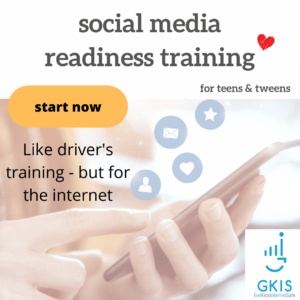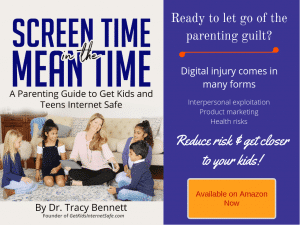No matter how much we want to keep our children from experiencing the terrible things in life, it is impossible to shelter them completely. They will fail. They will get stressed. And they will experience loss. A challenge is figuring out when to step in for prevention or help them cope and when to arrange for expert treatment. Since the pandemic, the need for mental health treatment has skyrocketed. There aren’t enough mental health providers to meet the need of children and teens. Today’s article covers how to best help your kids through challenging times. In response to recent events, Dr. Bennett has created a FREE FAMILY GUIDE FOR COPING WITH TRAGEDY. Please download and share it on your social media with friends and family. If you’d like to help your family develop better communication and more awareness and accountability, check out our Screen Safety Essentials Course. It offers everything you need to close screen-risk gaps and improve overall mental health.
Being Proactive
Being a parent is the most rewarding challenge we face. At the same time, it is often difficult and goes largely underappreciated. As the world continues to unleash tragedy after tragedy, it’s our job to guide our kids safely through to the other side. That requires support on our end for certain but also skill-building on theirs. Having the right tools to deal with these threats to family happiness and cohesiveness can make the difference between being a good parent and a great parent.
Staying Vigilant
Without knowing what to look for, it may be impossible to identify early warning signs that your child is in trouble. While hindsight is 20/20, it can be difficult to notice the small indications that your guidance is needed. No one knows your kid better than you. You’re the most capable person for noticing changes in their behavior. If your parental instincts are signaling that something is wrong, increase monitoring and follow up.
While it is important to actively communicate with your child, it can be difficult to steer the conversation in a way that puts them in a position to tell you what they need. Listening is a critical parenting skill.
To encourage your child to open up, ask a non-leading general question that will not influence their answer, such as “Is there anything bothering you?” or, “Have you heard or seen anything that is upsetting recently?” By asking general questions that allow them to direct the conversation, you can effectively gauge how your kid is doing and choose a proper strategy to guide them.
Treading Gently and Honestly
Honesty is important when dealing with kids. After all, trust lies the foundation for ongoing and open communication. Because kids can “sense” when there is something going on, creating an environment of openness and receptivity is key.
Although there is no clear “right” or “wrong” way to teach kids about tragedy, offering reassurance that they are safe and letting them know you will cope as a family is of great importance. Being honest about your feelings offers an excellent model of vulnerability and courage, while reframing challenges offer hope and opportunities for closeness and growth.

Being present and spending time together as a family is of huge comfort to kids. Research has shown that spending quality time with children helps them to develop mental and emotional fortitude.[1] By spending quality time with your child, they feel more protected and are less likely to develop behavioral problems, and are more likely to develop better emotional regulation skills. Thus, children of parents who spend quality time with them become better equipped to deal with stressful situations.
Validating Their Feelings
Emotional validation is the expression of acceptance of another person’s emotional experience through learning and understanding.[2] When a parent is accepting and understanding of a child’s feelings, the child is more likely to feel loved and respected. When a child’s emotional experience is not validated, it can lead to feelings of rejection and psychological distress.
Keen emotional intelligence is needed to effectively recognize one’s own emotions and manage them in a healthy way. Yet, children often do not have the emotional intelligence and the emotion regulation skills necessary to deal with stressful stimuli. That develops with patient coaching and modeling from caring and engaged parents.
Distress tolerance is a person’s ability to prevent oneself from becoming emotionally overwhelmed when confronted with stressful situations.[2] When confronted with stressful situations out of one’s control, it can be more difficult to regulate one’s emotions and effectively communicate one’s feelings. [3] Validation is a powerful tool to help children learn to regulate their emotions. When children feel that their emotions are validated, they become more willing to share how they feel, which leads to more honest dialogue and mutual respect.[2] First conversations offer the scaffolding for positive growth, and later conversations polish those skill sets and offer deeper, more complex abilities.

Not every child will need therapy in their life. However, if you feel your child is demonstrating severely impairing symptoms, are not making improvement over time, or are demonstrating self-harm or suicidal ideation, it may be time to seek expert help. Dr. Bennett has been offering psychotherapy for children, teens, and adults for over 25 years. Although she does integrate play therapy into sessions, she feels the most powerful change happens when she works as a team for the family to set measurable goals, offers behavioral incentives and rewards, and offers cognitive-behavioral and dialectical behavior toolkits like those offered in the GetKidsInternetSafe Essentials Course for the family and our Social Media Readiness Course for tweens and teens.
Behavior Therapy (DBT) teaches distress tolerance and emotional regulation skills to process emotions and problem-solve without becoming overwhelmed.[1]
DBT can teach a child these skills:
- recognizing when a situation is out of their control and accepting the fact that they cannot change it
- learning to self-soothe – using adaptive coping skills to relieve stress and anxiety
- learning to recognize and stop impulsive behavior in favor of thinking rationally
- learning to assess the pros and cons of one’s actions before reacting
- learning to utilize TIPP skills – skills to quickly calm the limbic system and reset one’s emotional arousal levels
To help you to implement technology and maintain a healthy family dynamic, you can download the free GKIS Connected Family Agreement simply by creating a GKIS account on our website home page.
If you are looking for other useful tips about how to make the internet a safer place for your family, you can get parenting and family coaching information, support, and other valuable information from the GKIS Essentials Course. Also, check out the GKIS blog for other entertaining and informative articles.

I’m the mom psychologist who will help you GetKidsInternetSafe.
Onward to More Awesome Parenting,
Tracy S. Bennett, Ph.D.
Mom, Clinical Psychologist, CSUCI Adjunct Faculty
GetKidsInternetSafe.com
Works Cited
[1] Jones, C. (2017). What are the benefit of spending quality time with your kids. 10 Minutes of Quality Time. https://10minutesofqualitytime.com/what-are-the-benefits-spending-quality-time-kids/ [2] Linehan, M. M. (2014). DBT skills training handouts and worksheets. Guilford Publications. [3] Chapman, A., Gratz, K., & Tull, M. (2011). The dialectical behavior therapy skills workbook for anxiety: Breaking free from worry, panic, PTSD, and other anxiety symptoms. New Harbinger Publications.Photo Credits
Photo by Trym Nilsen (https://unsplash.com/photos/eXV-LsWfCOo)
Photo by Michal Parzuchowski (https://unsplash.com/photos/W9ULJJwG2fA)
Photo by SI Janko Ferlic (https://unsplash.com/photos/KQCXf_zvdaU)
Photo by Jordan Whitt (https://unsplash.com/photos/KQCXf_zvdaU)
Thanks to Kent Williams for the beautiful painting used for the thumbnail. (https://www.kentwilliams.com/paintings/2018/8/16/2018/8/16/m-w)












